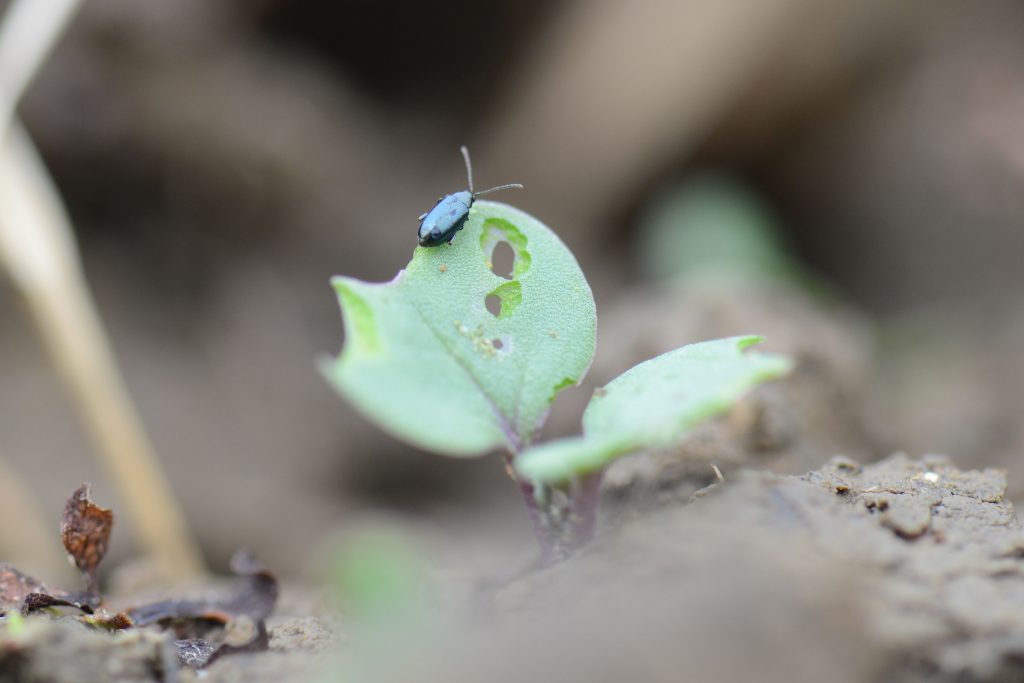Timely sprays to protect emerging OSR
13th September 2016
Most oilseed rape growers have opted for earlier sowing this season, in an effort to get crops up and away ahead of flea beetle damage. Warm soils has certainly helped

Flea beetle feeding.
Most oilseed rape growers have opted for earlier sowing this season, in an effort to get crops up and away ahead of flea beetle damage. Warm soils has certainly helped with germination, but the bright hot weather has now increased insect activity.
Timely spray applications can help to get seedlings safely established, with some useful tips to get the best possible results, reported Syngenta Field Technical Manager, Max Newbert.

Max Newbert.
“Pyrethroid applications when Flea Beetle or Cabbage Stem Flea Beetle feeding is seen to be hitting seedlings remains the key first step for growers,” he advised. “But with pyrethroid resistance a recognised issue for some growers, it means Hallmark Zeon should always be used at the full approved rate.” Application at the full rate will also give the highest level of repellency action to minimise damage.
Research at Syngenta Jealotts Hill in Berkshire has demonstrated the repellency activity of Hallmark Zeon can halve the number of Flea Beetles attacking treated seedlings for more than 24 hours after application, compared to untreated. Protection of plants through to the second true leaf emerging has been identified as having a significant impact on overall survival rates.
Growers and agronomists should be looking to differentiate Flea Beetle and Cabbage Stem Flea Beetle attacks, added Max. Flea beetle feeding results in the severe shot holing damage; they are more difficult to control, requiring Hallmark Zeon rates of 75 ml/ha, he advised. Cabbage stem flea beetle also cause the initial damage at establishment, along with the potential severe effects of larvae feeding in the spring, from eggs laid in the soil now; the approved Hallmark Zeon rate for CSFB control is 50 ml/ha.
Max warned that cloddy seedbeds, often created in dry conditions, provided ample opportunity for adult beetles to hide, especially if consolidation had been difficult following stubble incorporation. Application with angled Defy 3D Nozzles, alternated to face forward and backward along the boom, could deliver far more effective spray coverage all around clods and seedling plants, he advised.
In the flea beetle hotspot of Essex, John Haynes, farm manager for MJ & SC Collins, based at Kingstons Farm, Harlow, has gone to greater lengths to create a firm, fine seedbed this season – and sown earlier, in the first week of August. But even then crop have been emerging with visible flea beetle shot holing on the cotyledons, requiring repeated early treatment to try and prevent further damage.
“We have introduced hybrids for autumn vigour, and also given it a bit more nitrogen in the seedbed, to keep it growing strongly from the early sowing,” advised John. But conditions have been extremely difficult this season, with significant areas lost to slug damage and set to be resown with barley, he added.
“Furthermore, last year in particular plants suffered severely from effects of cabbage stem flea beetle larvae feeding damage in the spring, so we have to remain focussed on controlling egg laying adults now.”
The farm’s sprayer operator, Garry Chambers, advocated application at a water volume of 175 l/ha using 04 Defy 3D nozzles when targeting Flea Beetle, which he believes gives the optimum combination of effective coverage and sufficient concentration to deliver an effective hit. Applications of Hallmark Zeon are always maintained at full rate.
Garry also pointed out that spraying at no more than 14 km/hr helped assure even coverage, even though the smoother seedbeds and sprayer capability would allow him to go faster.
New Syngenta application trials this autumn will be looking at maximising flea beetle control from Hallmark Zeon treatments – including nozzle selection, water volume and even the option of spraying at night, when entomologists highlight Flea Beetle are more active.
Syngenta Field Technical Manager, Max Newbert, added: “With the formulation of Hallmark Zeon you get over 7800 times more active capsules per ml of product, compared to some other lambda-cyhalothrin products; that significantly increases the chance of hitting beetles with sufficient active.
“Furthermore, we know the UV protection built-in to the Hallmark Zeon formulation can make it more effective in warm, bright early autumn conditions, when flea beetle are most active on newly establishing OSR. New research is also being investigated on its repellency activity, which could further help to keep beetles off treated crops for longer and allow them to grow away.”
Top tips for flea beetle control
- Fields close to last year’s OSR are at highest risk
- Cloddy or loose seedbeds more susceptible
- Treat at the first signs of damage
- Use Defy 3D Nozzles for coverage
- Always use full dose rate applications
- Spray at 100 – 200 l/ha water volume
